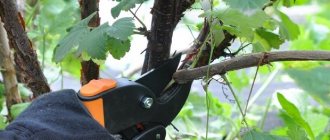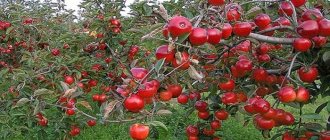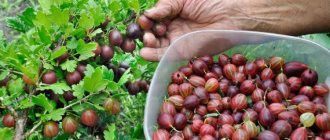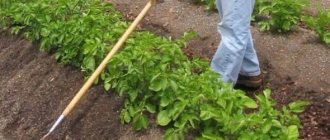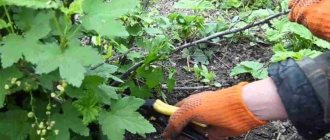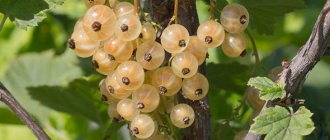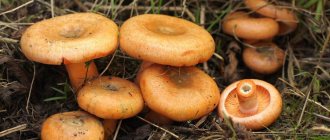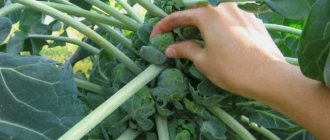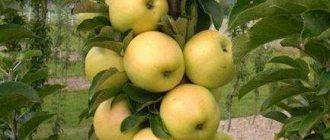Autumn tillage of soil in the bush area
To provide the crop with optimal conditions, it is necessary to cultivate not only the plant, but also the soil around it. In the autumn, after picking berries, buds form on the gooseberries for future flowering, so care must be special.
Tillage is also necessary to protect gooseberries from the development of diseases in the spring and the invasion of pests (some insects easily survive wintering in the ground and remaining plants).
Removing weeds and fallen leaves
The best habitat for pests is garbage and weeds, which experienced gardeners recommend getting rid of. In autumn, collect fallen leaves and then remove weeds by hand.
If the weed cannot be pulled out by hand, carry out weeding, especially if the grass is deeply rooted (it will draw juices from the gooseberry rhizome).
Pay special attention to crushed and rotten berries that have fallen off - do not leave them under the bush, otherwise fungal diseases will arise.
If fallen leaves show signs of disease, burn them along with other debris. If not, set aside for compost.
Digging and loosening
Loosening the soil in the bush area is necessary to saturate the soil and gooseberry root system with oxygen. Otherwise, if there is a shortage of it, the roots will begin to rise upward in winter, which leads to freezing.
Digging is important because it destroys pests and prevents soil compaction. When carrying out this agrotechnical procedure, you should adhere to the following tips:
- do not break the clods, as is done in the spring - just turn the fork/shovel over;
- depth in the tree trunk circle – minimum 5, maximum 7 cm;
- recess between rows – up to 15 cm;
- Apply fertilizers during loosening;
- work carefully so as not to damage the gooseberry roots;
- Digging can also be done during the first frost.
Mulching and hilling
Gooseberries are subject to freezing, so mulching is used to protect the roots from the cold. Thanks to mulch, the soil retains its porous structure and maintains proper water and air conditions.
First, hilling is carried out with a layer of 10-12 cm, especially if the bush is infected with moth. The soil is raked in the spring immediately after flowering ends.
Various materials are used as mulch:
- peat raw materials;
- thoroughly dried leaves;
- rotted sawdust.
Mulching involves laying a layer of raw materials from 10 to 15 cm. The optimal mulch is peat mixed halfway with wood ash. This way the earth is enriched with useful substances, breathes, and maintains the desired temperature.
Fertilizer application
Due to the abundance of fruiting every year, gooseberries require enriched soil. To do this, the following nutritional compositions must be added in the fall:
- Phosphorus substance – enhances winter hardiness, branching, growth. Signs of phosphorus starvation are spots on the leaves, thinning shoots, poor bud formation. It is better to use double superphosphate - 30 g per plant.
- Potassium products - without potassium, the berries are small and underdeveloped, the leaves die off. For one bush you will need 20 g of potassium sulfate.
- Ash – saturates with useful substances, helps resist diseases and pests. Scattered under bushes 300 g.
- Compost – strengthens the plant’s immune system. It is applied in rotted form in quantities from 6 to 12 kg per bush, depending on the age of the plant.
Other pre-winter fertilizers:
- Experts recommend foliar feeding. For this, 220-230 g of Superphosphate preparation, 110-120 g of potassium salt and 9-10 liters of water are used. The bush is sprayed with the solution.
- As a mineral fertilizer, a solution or dry mixture of 100 g of ash, 15-20 g of potassium sulfate, 25-30 g of Superphosphate (8-10 l of water) is used.
- From store-bought products, a drug called “Autumn Fertilizer” is used. For one bush you will need 320-350 g.
How to process gooseberries after harvest?
Processing gooseberries begins with weeding around the bush. If weeding was not carried out throughout the summer, then many small and large weeds grew under the bushes. They should not be pulled out, as roots may remain in the soil, but carefully dug up with a shovel so as not to damage the gooseberries. You also need to use a rake to collect accumulated debris and fallen leaves, since many pests and pathogens of various diseases remain overwintering under it.
Gooseberry pruning should begin at 6 years of age. Weak root shoots must be cut out the next year after planting the shrub, choosing 3 to 4 strong shoots. First of all, broken branches, damaged by diseases and pests, old and low-bearing branches are cut out. A well-formed bush should have up to 18 branches of different ages, sparse enough to provide light and air access to the inside of the bush and facilitate subsequent harvesting.
How to prune gooseberries correctly - video:
After the leaves fall during a dry autumn and a large harvest, it is necessary to water the gooseberries. Such watering is very important on light and sandy loam soils. At the same time, root growth increases, and the bush is better prepared for frost.
For good development of the bush and regular fruiting, it is necessary to dig up and loosen the soil. Unlike spring digging, during autumn digging the soil is not broken, but turned over with a pitchfork, since large lumps retain moisture in the soil during the autumn and spring periods. The roots of the gooseberry are located close to the soil surface, so treatment under the crown of the bush should be carried out very carefully, to a depth of no more than 7 cm.
Due to the abundant fruiting, gooseberries require intensive feeding.
During digging, the following fertilizers are added to the soil under one bush:
- up to 10 kg of compost or rotted manure;
- 20 gr. potash fertilizers (potassium sulfate);
- 30 gr. phosphate fertilizers (double superphosphate);
- 300 gr. stove ash.
The best results will be obtained by liquid organic fertilizer in the form of a diluted infusion of mullein or bird droppings.
The purpose of these fertilizers is to prepare the shrub for the formation of flower buds next year.
It is advisable to sprinkle humus or peat mixed with ash on top of the soil dug up under the bush to a thickness of no more than 10 cm. This layer covers both the inner zone of the bush and the bite strip. Due to mulching, the water-air, temperature and nutritional regime of the top layer of soil improves, the roots are protected from freezing, and the growth of weeds is reduced. It is advisable to mulch the soil before frost sets in.
Watering gooseberries in autumn
Gooseberries love moisture, so special attention is paid to watering. If moisture-replenishing watering is not carried out in the fall, the roots and branches of the plant dry out and freeze out under the influence of frost.
Rules for moistening the soil before wintering gooseberries:
- during heavy autumn rainfall, watering is not carried out;
- in dry and warm weather, apply 30 to 60 liters of water under each bush (depending on age - the older the plant, the more liquid);
- water is poured into the grooves around the trunk or directly under the root;
- moistening is carried out 3-4 days before digging the soil.
Gooseberries require such a large amount of water due to the highly developed root system, which goes into the deep layers of the soil.
Treatment of the root zone
Gooseberries in autumn.
Mulching the tree trunk circle From spring to autumn, the gardener monitors the cleanliness of the tree trunk circle of berry bushes: removes weeds, loosens, mulches. After all, hygiene in the cultivation of fruit crops is a third of success. But, despite this, after harvesting the gooseberry bushes in the fall, there is no end to the work:
- The first step is to rake out fallen berries and leaves. If traditionally prickly varieties grow, then, protecting your hands with thick gloves and armed with a convenient tool, including tweezers, they restore order between the gooseberry stems, without leaving any plant residues before winter.
- If there are diseased, mummified fruits left on the branches, they must be removed. Not a single berry should remain on the gooseberry before winter. This will deprive fungal spores or pest larvae of comfortable wintering conditions.
- Weeds that have managed to appear are pulled out. The upcoming feeding will provide them with a rich nutritional base: the weeds will grow, taking away nutrition from the gooseberries.
- When the trunk circle and the space between the stems are completely cleared, the soil is carefully loosened. The closer to the center of the circle, the shallower the depth: there the soil was not so trampled down while the harvest was in progress. Towards the outer circle of the crown projection - deeper: during the removal of fruits around the bush, the earth was compacted with feet, so air access to the roots is limited.
- Outside the crown projection, where there are no more gooseberry roots, the ground is dug up. Depending on the distance between the bushes and the spread of the roots of neighboring plantings, digging from half to full bayonet depth.
- The tree trunk circle is sprinkled with a continuous layer of wood ash. The double effect of this measure is additional feeding of gooseberries and a blow to pests and their larvae.
- The last stage is mulching the tree trunk circle. A thick, at least 10 cm, layer of mulch will protect the roots from freezing and create more comfortable conditions in winter.
If you use compost and humus, then two problems are solved at once - insulation + fertilizing. Important! You can cover the ground with peat, rotted sawdust, and straw. But the last two options often harbor mice. Small rodents love to eat gooseberry trunks in winter. For protection, rubber hoses, car tires or tube cuttings are laid out around the stems.
Autumn rules for pruning gooseberries
Since gooseberries are a berry crop, they grow rapidly, which leads to self-shading. As a result, the level of productivity and fruiting decreases.
The bush formation procedure has the following advantages:
- the supply of light and air to the internal branches of the bush improves;
- the risk of pest damage and disease development is reduced;
- simplifies care;
- the quantity and quality of the harvest improves, the fruits become larger;
- Gooseberries bear fruit every year.
Untimely and incorrect trimming of the bush leads to weakening of the plant and a decrease in immune properties. Pruning is carried out in 2 stages - after harvesting (sanitary - late July-September) and after leaf fall, that is, from October to November (in the North a little earlier, depending on the climate).
When carrying out sanitary pruning of gooseberries in the fall, you need to remove the following parts:
- dry and damaged branches;
- elements affected by pests and diseases (after pruning they are burned);
- branches lying almost on the ground are cut down to stumps (they are always in the shade, infection occurs through them);
- shoots that are confused with others grow inward or in the center of the bush - to the point of branching;
- shoots 5 or more years old;
- young weakened growth;
- thin sprouts.
Branches that grow horizontally or downwards are shortened to buds that are directed towards vertical growth.
Formative and rejuvenating autumn pruning (after leaf fall) has the main rule - the strongest branches are left, which will be evenly spaced relative to each other.
Step-by-step scheme for autumn pruning gooseberries:
- Inspect the bush and remove the leaves that remain on it.
- Use pruning shears to cut branches with cracks, lichen crust, and blackened areas. The same applies to branches that are more than 5 years old, since after this period of life their fruiting decreases.
- Get rid of shoots lying on the surface of the soil. They practically do not produce a harvest, but through them they become infected with pathogenic microbes.
- Trim off any broken, dry or disease/insect infested shoots.
- Start shaping - spread the center of the bush with your hands and remove from there the branches that cross with others or grow horizontally and those that thicken the plant.
- Do not remove strong branches that have the wrong direction of growth, but turn them in the other direction, securing them with wire or rope.
- Treat the cut areas with a special insulating paste and remove the trimmings from under the bush.
Caring for gooseberries in spring
Timely spring measures to care for fruit and berry crops will lead to a large harvest in the future. Experienced gardeners recommend doing them before the first buds form. For this:
- They remove the winter shelter - the timing depends on the region, in the central and southern regions at the beginning of March, in the northern regions - later. Then the mulch, the remains of last year's vegetation, and branches are raked out. Afterwards, all the garbage is burned, as fungal spores and insect larvae overwinter in it. If the bushes are not covered, but simply bent to the ground, they need to be raised.
- When the snow melts, cover the ground with dense material for several weeks to prevent pests from laying offspring.
- They are treated against pests and diseases - the plant and the soil around it are watered with boiling water, but only until the buds appear. To do this, use a metal watering can. They are also sprayed with copper sulfate, Bordeaux mixture, and fungicides: Fitosporin, Actofit. In this case, the treatment is carried out at an air temperature not lower than +14 °C.
- Water at the root or using a drip system during flowering. The top layer of soil is moistened to 30-40 cm, but not with cold water. Because of this, immunity is reduced and there is a risk of fungal diseases.
- They do sanitary pruning in early March - remove dried, frozen, damaged, diseased, weak, twisted branches, intersecting shoots that are located too close to the ground. The cut is made above the bud, 6 mm away from the eye, at a slope of 50°.
- At the beginning of May, the ground around the bush is loosened to a depth of 8 cm. Then mulched with straw, hay, peat, and sawdust. This will reduce evaporation and prevent weeds. They dig 10-15 cm between the rows.
- Fertilizing is done from the second year of planting. At the beginning of the growing season, urea or ammonium nitrate is added. Scatter under the bushes, embed 5 cm into the soil, and water. For adult bushes – 40-60 g, for young bushes – 30-40 g. They also use potato peelings - one kilogram per 10 liters of boiling water. After cooling, add 200 grams of wood ash or bird droppings 1:20. A bucket is poured under each bush. Manure and humus. Before flowering, potassium sulfate is added - 40-50 grams per bush. This is provided that the plants were not fertilized in the fall.
Pre-winter treatment against diseases and pests
To increase the yield and healthy development of the bush, in the fall it is necessary to protect the plant from pathogenic insects and diseases. Processing is carried out from the last ten days of October to the first week of November.
The following drugs are used for the procedure:
- Insecticides. Diluted per 10 liters of water - Bitoxibacillin (100 g), Lepidocid (one package), Actellik (15 ml).
- Fungicides. The drug Topaz - 1 ampoule for 9-10 liters of water, Fundazol - 10 g for 9-10 liters of liquid.
Other means of controlling diseases and pests in autumn:
- Iron sulfate (3%) and Bordeaux mixture (2-3%). Shrubs need to be sprayed after leaf fall. The products are used against various insects and diseases.
- Oxychloride. Protects against goblet rust, anthracnose and septoria. For 9-10 liters of water you need 40 g of the substance.
- Karbofos. Necessary for moths, sawflies, and aphids. For 9-10 liters of water you will need 20 g of the drug.
- Ash mixture. Used to protect against various diseases and insect attacks. For 10 liters of water, take a mixture of equal amounts of onion peels, ash, potato tops and garlic - 1 kg.
Pest Control
Various insects and mites cause considerable damage to plantings. Among the dangerous pests of gooseberries:
- bud moth;
- moth;
- gooseberry moth;
- shoot aphid;
- currant borer and gall midge;
- currant glass;
- spider mite;
- gooseberry sawfly.
For prevention, as well as for minor injuries and a small number of insects, folk remedies and biological products are used.
If there is an invasion of pests, then you will have to treat the bushes with chemical compounds - insecticides and acaricides, strictly observing the timing and proportions.
Pest control treatments in spring
Until the soil thaws, spraying on dormant bushes is effective, when many pests have not yet emerged after wintering. It is convenient that many of the formulations used in the spring against infections also help in the fight against insects.
On a note! In spring (before leaves appear) and autumn (after they fall), only contact insecticides are effective.
Use:
- Bordeaux mixture;
- iron and copper sulfate;
- "30 plus."
The above compositions prepared according to folk recipes are suitable:
- ash infusion;
- solutions of soda ash or baking soda.
Experienced summer residents spray gooseberry bushes with a solution of urea (carbamide), which is destructive to pest larvae (especially aphids). Proportions: per bucket of water - 500 g of fertilizer.
During the green cone stage, the use of chemicals is permitted:
- "Aktara" is an insecticide of mixed (contact-intestinal) action. Available in granules and suspension form, it is a low-toxic product;
- "Inta-Vir" is a broad-spectrum product that is safe for animals and humans. Use only in dry weather (washed off by rain). Effective against sawflies, aphids, leaf-eating caterpillars;
- “Karbofos” is available in the form of powder, ready-made working solution, and concentrated suspension. Acts against sawflies, moths, mites (partly);
- “Actellik” is an insectoacaricide that saves gooseberries from mites, as well as from a number of other pests. Release form: concentrated emulsion. Dilute: 2 ml of product per 1 liter of water, spray from a spray bottle.
The products are effective, but work selectively (against larvae and adults or only against adults). If the pests have managed to lay eggs, then very quickly the plantings will be attacked by a new army of voracious insects.
Before flowering, it is advisable to re-treat the gooseberries, making sure to observe the intervals between treatments. All information is indicated in the instructions for the drugs; it cannot be ignored!
Pest control in summer
In the summer months, insidious insects do not sleep; they attack garden plantings. Some survive after spring treatments, others penetrate the site from neighboring dachas.
At this time, chemicals cannot be used. Biological preparations, manual removal of insects, as well as folk remedies are used.
Proven to be excellent:
- "Bitoxibacillin" - works against moths, aphids, mites (acaricidal effect). Take 100 g of the drug per bucket of water (10 l);
- "Lepidotsid" - available in the form of powder or suspension. Repels butterflies and is effective against moth larvae. To prepare a solution, add 30 g of the product to 10 liters of water;
- "Nemabakt" - contains bacteria and nematodes that destroy moth larvae and glass beetles. Warm water is prepared, a sieve and a sponge with the composition are placed on the tank. Sprinkle with water to obtain a working solution. Approximately 10-12 liters are consumed per hundred square meters.
Among the folk remedies used to combat aphids, the following solutions are used:
- flea shampoo;
- laundry soap;
- fir oil;
- birch tar;
- ammonia.
Summer residents speak positively about infusions of tobacco, wormwood, decoctions of garlic, tansy, burdock, and onion peels. The crushed raw materials or powder are poured with water, brought to a boil and cooled. The proportions are arbitrary, depending on the scale of damage to the plantings.
Do not forget about manual collection of pests. In summer, a film or tarpaulin is placed under the bushes and the gooseberry branches are gently shaken. This is how sawfly larvae and moths are collected.
What do they do in the fall
Before the onset of cold weather, gooseberry plantings, like other berry bushes, are pruned. Carefully dig up the soil, remove and burn plant debris.
The shoots are washed abundantly with solutions of baking soda or soda ash, soap emulsion, and treated with Bordeaux mixture (1%). The soil is mulched with peat, compost, and pieces of pine bark. To combat moth (pupae overwintering in the ground), it is recommended to cover the ground under the bushes with film or roofing felt.
If the plantings were attacked by sawflies, spider mites or aphids in the summer, then it is advisable to treat the bushes with Karate, Acrobat, Actellik, and Inta-Vir preparations.
Gooseberry shelter for the winter
For residents of the Middle Zone and the South of the country, covering gooseberries is an optional procedure, but for the Northern regions it is necessary. Gooseberries do not tolerate frosts below -35-40°C.
Not all materials are allowed to be used to insulate a bush. An ideal shelter option would be:
- spruce spruce branches;
- propylene fabric;
- spunbond;
- agrofibre;
- polycarbonate;
- sackcloth;
- lutrasil, etc.
It is strictly forbidden to cover gooseberries with plastic film, as the plant is subject to damping off, which promotes rotting.
The insulation procedure is carried out when cool weather stabilizes. If thaws are planned, the bushes should not be covered.
The gooseberry insulation scheme is very simple to implement:
- Hill up and mulch the root zone.
- Wrap all the branches with twine to make one bundle.
- Press the bunch to the surface of the ground and cover the branches with the selected material.
- Sprinkle soil around the edges of the material to prevent it from flying off in the wind.
If the bush has too rigid branches due to age, you can use a simplified method of covering - just cover it with material without tying it or tilting it. Place heavy objects (bricks, stones) around the edges and sprinkle with soil.
If the winter is snowy, then the best option would be to cover it with a layer of snow on top of non-woven material. In very severe frosts, gardeners advise additionally sprinkling the wrapped branches with a 5-8 cm layer of dry grass, which will not allow the cold to penetrate inside.
Top dressing
After abundant fruiting, gooseberries need feeding. Phosphorus-containing fertilizers allow the bush to form a sufficient number of buds to grow green mass in the future, allow the shoots to grow stronger, the wood to ripen, and the gooseberry to withstand frosts more easily. Lack of phosphorus affects the sugar level of future fruits. Without potassium, gooseberry berries become smaller and do not have time to ripen on time, the leaves become streaked and die. Humus and compost enrich the crop with nutritious organic substances. Wood ash contains not only phosphorus and potassium, but also fights pests in the soil.
Rules for preparing gooseberries for winter, based on regions
The timing and rules of preparation for wintering crops depend on climatic conditions:
- South of Russia. Work is carried out until the first ten days of November at the latest. Attention is focused on watering, since the climate is considered arid, so a minimum of 50 liters of water is used per bush.
- Moscow region and middle zone. Preparation must be completed by October 15. Since the soil here is podzolic and acidic, it is recommended to carry out additional liming and add minerals and organic matter in large quantities.
- North, Siberia, Ural. Preparatory activities should begin in mid-September. Feature - you cannot carry out formative pruning in the fall (do it in the spring), but it is necessary to carry out sanitary pruning.
On flat flat landscapes that are blown by winds, snow retention is established (drifts are created next to bushes for protection).
The main principle of preparing gooseberries for wintering for all regions of Russia is to have time to complete the activities before the onset of the first frost.
Common gardening mistakes
If a gardener makes mistakes in the rules for caring for gooseberries, he risks getting a minimal harvest and small berries. In some cases, errors lead to the death of plants.
Most often, novice gardeners make the following mistakes:
- excessively deep digging around the bush, which leads to damage to the root processes;
- neglect of pruning and shaping or excessive manipulation;
- exceeding the dosage of applying nitrogen-containing fertilizers in the autumn (nitrogen is fertilized maximum at the end of July);
- fertilizing with unrotted manure;
- lack of mulch and shelter;
- trimming bushes during frosts;
- complete removal of shoots that are not older than one year.
An experienced gardener will tell you about preparing gooseberries for winter:
Gooseberries are long-lived in any garden, but provided all the rules for caring for the bush are followed. Since the crop does not tolerate severe frosts, it is necessary to strictly adhere to the requirements for preparing gooseberries for winter. Only in this case can you get a decent harvest of large berries.
0
0
Copy link
Rules and features of pruning bushes
Gooseberry is a berry bush, so it grows quickly, shades itself, gets sick more often and bears fruit worse. To prevent such consequences, it is recommended to carry out autumn pruning, as it contributes to:
- improving the flow of sunlight and air to the branches located inside the bush;
- reducing the risk of developing diseases and damage from harmful insects;
- giving the bush the correct shape, so it will be easier to care for the plant.
Meanwhile, it is worth understanding that incorrect and untimely pruning will make the shrub weak and worsen its productivity. So, after picking the berries, it is worth determining the optimal timing and rules for carrying out this garden manipulation.
When to prune?
You need to focus on pruning shrubs in November, and this procedure is carried out in two periods:
- After the harvest . Sanitary pruning is carried out, during which dried and diseased branches are eliminated.
- After leaf abscission . The rejuvenating and formative version of pruning is carried out after the leaves fall, but before the cold weather arrives and sub-zero temperatures set in.
Autumn pruning is to leave 5 strong shoots evenly spaced to each other. They should bear fruit next year.
What to trim?
Need to trim:
- all branches affected by any disease, dried and with visible damage;
- branches with a very low location (other shoots cast shadows on them, they lack nutrition and solar heat, and therefore do not produce a good harvest);
- branches with excessive crown thickening (they grow in the center or inside the plant itself and begin to get tangled with other branches);
- all old branches (five years old and older).
Young and weak growth with thin branches is shortened to the largest bud. It should not go to the inside of the bush, but to the outside.
There are also so-called “zero” shoots growing from the ground. If they are strong, they should be cut back by a quarter above the buds for optimal branching. Weak shoots must be completely cut out to prevent shading of the crown. The number of shoots should not be more than four.
Proper pruning technique
It is better to trim an old gooseberry bush using a lopper or a sector that has long handles. Of course, you can also use a regular pruner, which is designed for cutting young branches, but when working with it you can get pricked, since the bush is thorny. To protect your hands, you should wear protective gloves, such as welding gloves.
Using a sector, it is necessary to cut all the lower and old branches, as well as replacement shoots, to the base. Excess growth and competing branches should also be eliminated without stumps, in close proximity to the branching area. It turns out that pruning the old branch goes to the place where it branches or there is new growth.
In order to more successfully shorten fragile young shoots, it is important to find a strong bud on the outside and trim above it with an indentation of a centimeter.
Young shoots differ from old ones in that they are thinner and lighter. Thus, old shoots are quite thick and have a dark brown tint, close to black. Consequently, as gooseberry branches age, they become thicker and darker.
The blogger shares tips and recommendations for pruning gooseberries in the video below:
Scheme of culture formation by year
To get strong bushes and good yields, it is advisable to follow a clear pruning scheme by year:
- immediately after planting the seedlings , all shoots are shortened, leaving 3-4 buds above the soil surface;
- after 1 year - all shoots are pruned by 4-5 buds, leaving a few zero shoots (during the same period, sanitary treatment begins - diseased branches and those directed to the center of the bush are removed);
- after 2 years , the zero shoots are pinched (by 1/4), and the growth on the skeletal branches is also shortened;
- after 3-4 years - they will do all the same manipulations as in the previous period, not forgetting about sanitary pruning;
- in the 5th year and beyond - sanitary pruning is carried out, and then rejuvenating, completing the process with manipulations like 2 years.
Every year you should definitely leave 2-3 new zero replacement shoots.
Formation of a trunk
The standard method of forming a bush is also used, which makes caring for it easier. The method consists in the formation of a round shrub with branches of different ages. It is important to determine the height of the trunk. A meter is considered standard, so the side shoots are leveled to this level.
A soft tube, a little more than a meter long, is put on the trunk to prevent the passage of light, and the bush is tied to a support for the fortress. Next, strong young branches are shortened to about half the length, and old ones (from 7 years old) are removed completely.
This method significantly saves space on the site and provides good lighting. But for this type of pruning, you should choose only frost-resistant gooseberry varieties, because a tall bush is less resistant to cold.

